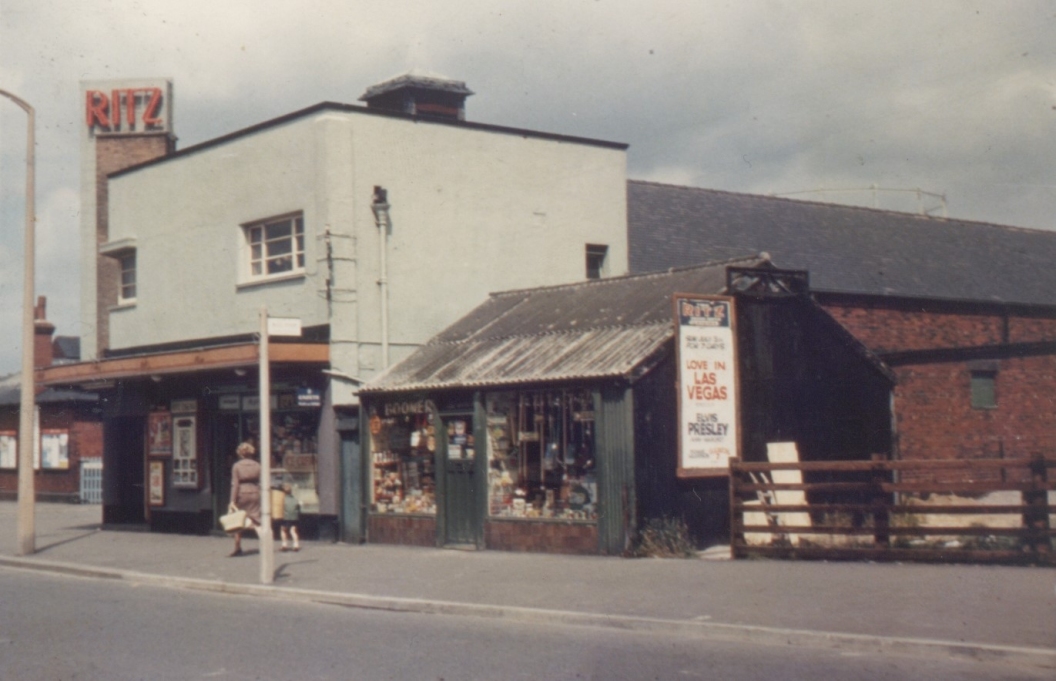 Ritz Cinema, Station Road, Cross Gates, 1950s On the 11th July 1938 Ernest Rudland Wood, his son Arthur Rudland Wood and their company Rushford Estates Limited purchased the Cross Gates Picture House from the Cross Gates Picture House Limited which was then put into voluntary liquidation. The Cinema had opened in 1920 and appears to have struggled to make the anticipated profits expected by its promoters. The opening of the Regal Super Cinema in Cross Gates, at the junction of Cross Gates Lane and Road, on the 16th November 1936 appears to have forced the sale to maximise some return for investors who all lost a substantial part of the money they invested in the venture. Click here for the history of the Cross Gates Picture House 1919-1939 Rushford Estates Limited already owned the Palladium Cinema and the Opera House in Ripon and Arthur had previously been manager at the Cross Gates Picture House and his father Ernest Rudland Wood had been involved with the house in the early 1920s. They had massive refurbishment plans for the cinema to enable it to compete with luxury Regal super cinema nearby. In June 1938, even before the sale completed, plans were drawn up by Nottingham based architect Reginald W. Cooper, and approved by the Police and Leeds Corporation. A loan of money was obtained from Barclays Bank. The alterations included changes to the seating and the front of the cinema was clad in an modernist style with a tower constructed of brick and art stone topped by a neon sign boldly stating the new name of cinema, gone was the Picture House, now it was the "RITZ". 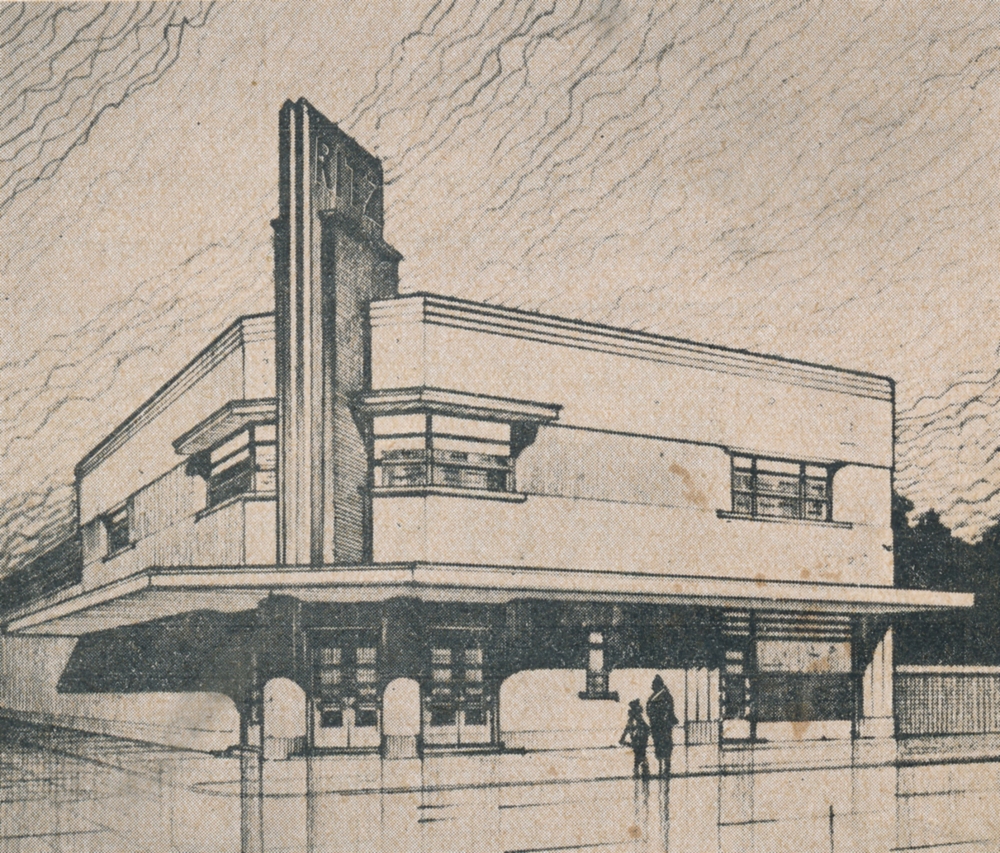 Ritz Cinema, Station Road, Cross Gates, 1938 A canopy projected over the pavement to keep customers dry whilst queuing for the house to open required extra approval from Leeds Corporation which was given on the 2nd September. Internally an old gas engine, which had apparently caused many problems over the years was scrapped and a modern rectifier installed, the screen was replaced with one made by Westone covered in millions of tiny glass beads suppose to give 50 per cent more reflecting surface. The front of the house was curved in towards the screen giving the impression of a much wider hall. Interior decorations were in green and gold with gold curtains for the screen. New projectors were also provided by Kalee Limited of Leeds. Seating was changed and the number increased from 475 to 636.  The sound system was replaced with the Western Electric Company's Mirrophonic apparatus, at the time widely reported as the best in the industry. The Ritz's advertising brochure reporting; "Consistent with their policy of always giving their patrons the highest entertainment value obtainable, the management of the Ritz theatre have installed Western Electric Mirrophonic Sound System. Mirrophonic is hailed as the greatest advance in film reproduction since Western Electric first made the screen talk ten years ago. Cinemagoers enjoy a closer contact with their favourite stars. When projected through Mirrophonic apparatus, talking pictures become so lifelike that it seems as if the stars are present in person in the theatre, talking, singing and acting on the stage. With Mirrophonic you can hear the accents and inflections of the stars' voices as they are actually heard in the studio when the film is being made. Singing voices are particularly clear and beautiful and all music is reproduced with wonderful fidelity." 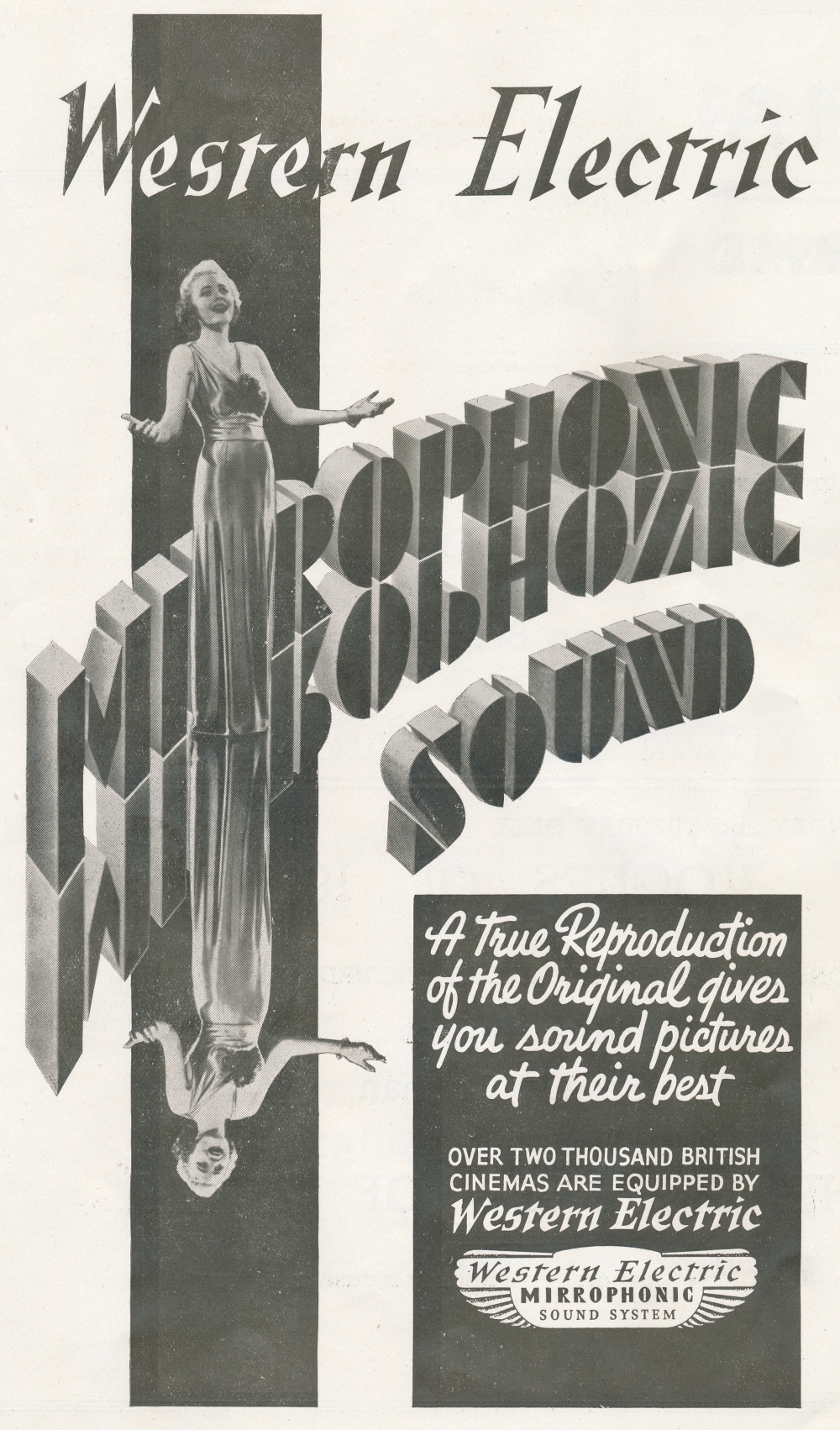 Owen Brooks the manager of the Cross Gates Picture House was retained as manager of the Ritz and the re-opening took place on Monday 19th September 1938 when Arthur Wood made a short speech and the Technicolour, musical comedy film "Vogues of 1938" was shown. 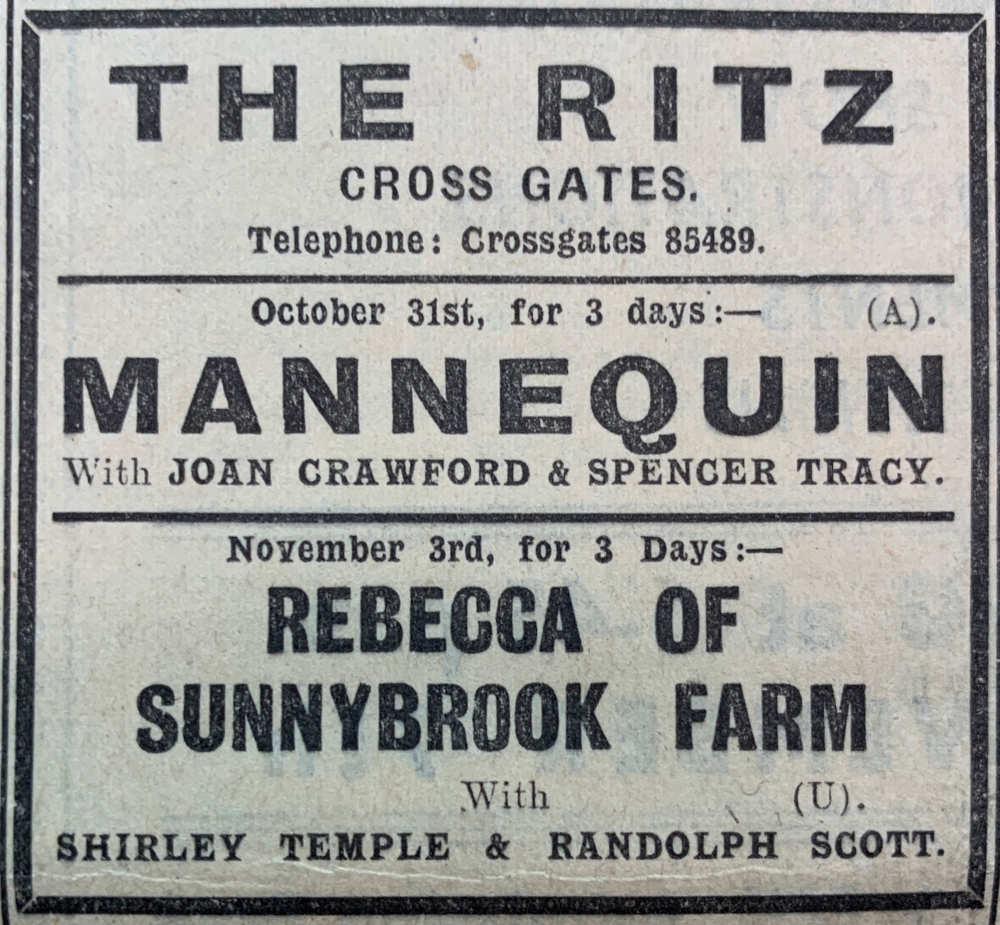 Skyrack Newspaper - 28th October 1938 As a result of the increase in capacity of the cinema Leeds Corporation increased the rates payable from £154 gross / £125 rateable to £300 gross / £247 rateable on the basis of 9 shilling 6 pence per seat. In January 1939 this was appealed in front of the Leeds Assessment Committee when it was stated that "Rushford Estates Ltd, the owners, said they agreed that there should be some increase, but considered the proposed increase excessive. The other cinema in the district, the Regal, which was a new super cinema occupying a more advantageous position, was assessed at 10 shillings 3 pence per seat, and they considered there should be a greater difference than ninepence between the two. The Regal charged higher prices and had a circle, which the Ritz had not. People would pay a higher price for circle seats." The Committee reduced the assessment to £255 gross and £209 rateable. On the 3rd July 1940 Rushford Estates Limited purchased 1430 square yards of land abutting the south side of the cinema from Arthur Wilson, a builder of Whitkirk, for £400. This land contained a small shop, fronting Station Road, and was used as a car park. The nearby Regal Cinema promoted its car park, which could accommodate 300 cars and at the time it opened in 1936 was stated to be the largest cinema car park in the north of England. Proposed extensions to the cinema building planned in September 1945 did not take place. A further 1738 square yards of land was purchased from the same seller on the 25th March 1946 for £550. 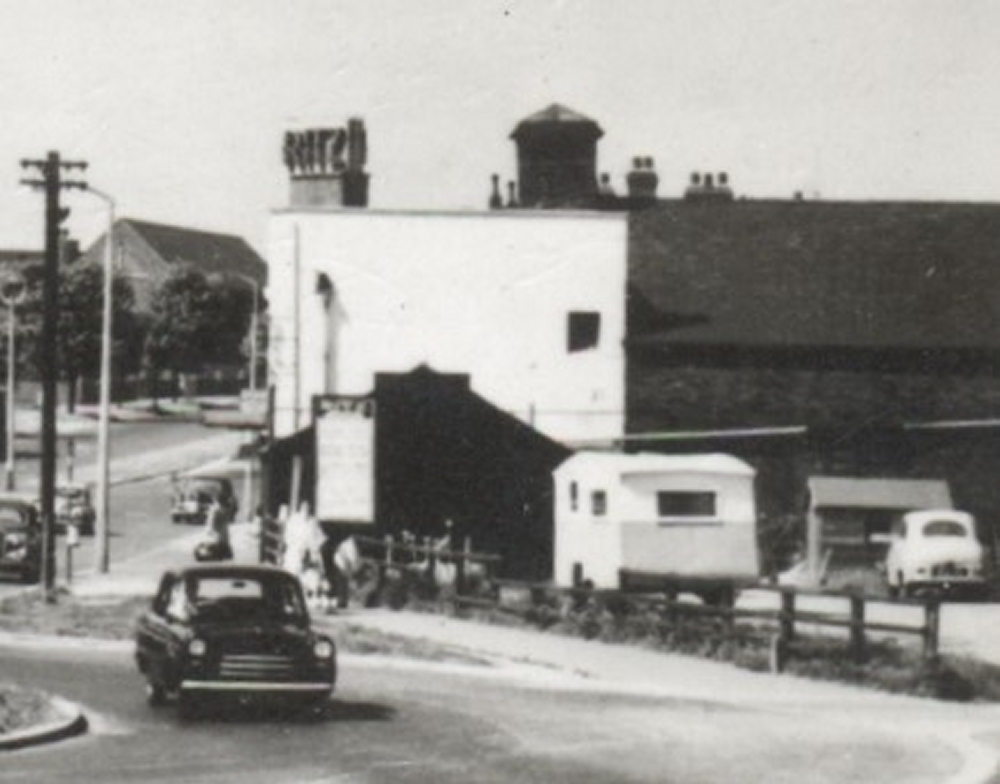 Ritz - 1950s At this time the cinemas in Leeds did not open on Sundays. The 1932 "Sunday Entertainment Act" of Parliament had allowed Sunday opening if a local public meeting or poll voted in favour and a levy was paid on each ticket sold for charity. This had been resisted for some time with the Leeds Council of Churches absolutely against it. Then in early 1946 the Local Labour party on Leeds Corporation proposed it and at a public meeting the vote went strongly against it, the Labour Party then demanded a full town poll. On Tuesday 19th March 1946 voting took place with an overwhelming majority in favour of opening although on a very poor turnout, perhaps indicated it was not the most important issue for people who had just emerged from the 5 years of World War II. Whilst the City Centre cinemas took advantage as soon as the necessary licensing arrangements had been made, the suburban cinemas were slow to take it up, the levy maybe making it commercially unattractive. The earliest Sunday showing I can find at the Ritz is from May 1951. 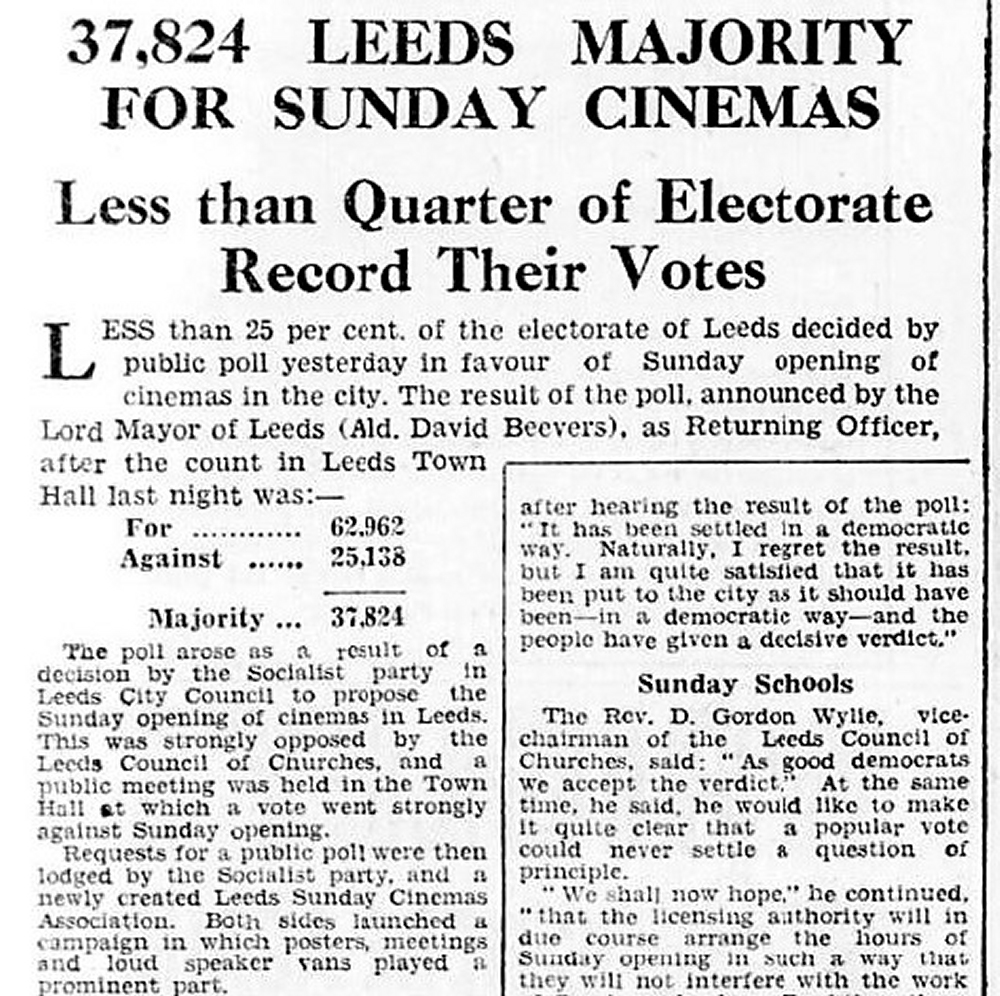 Yorkshire Post 20th March 1946 - Results of Leeds Poll Cinema manager, W. Owen Brooks died on 2nd September 1947 aged 84 having retired only weeks earlier, he was an interesting Leeds cinema pioneer, originally a studio portrait photographer in Dewsbury Road, Leeds, he knew Frieze-Green and also Augustin Le Prince, who invented the first cine apparatus in a Woodhouse Lane workshop, making a brief silent film on the 14th October 1888, now called ""Roundhay Garden Scene" and believed to be the oldest surviving film in existence and a few days later a film on Leeds Bridge. He disappeared in mysterious circumstances in France in 1890. Owen himself made his own camera and took film in 1900 from a horse drawn tram running along Boar Lane. He was also a motorcycle enthusiast building his own machine and obtained the 1st Leeds registration number "U1" 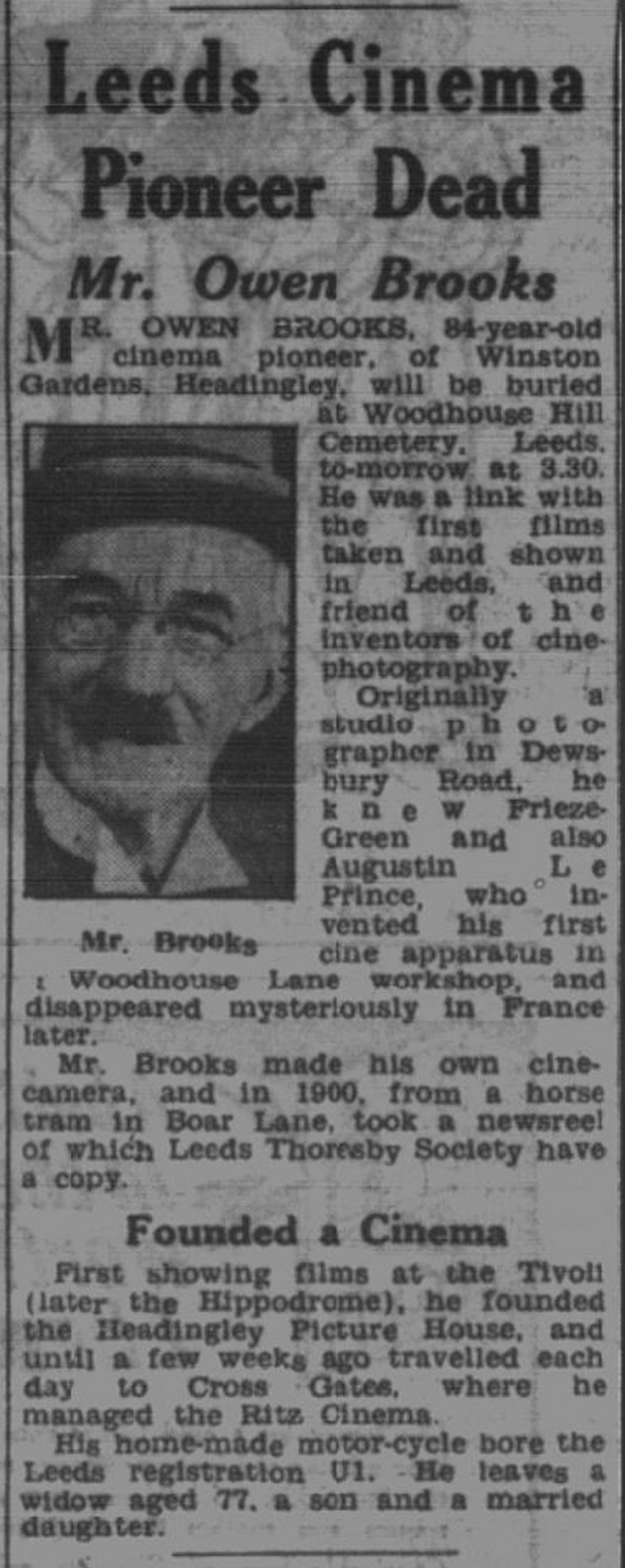 Yorkshire Evening Post - 3rd September 1947 - Owen Brooks Dies Following the death of Mr Brooks the managers license transferred to Gerald Charnley Howard and then in April 1952 to John P. Sayer. He stayed until late 1953 and shortly after left the UK to manage a drive-in cinema in California, USA. The early 1950s signalled the start of a long decline in the Cinema trade due to the arrival of television entertainment beamed direct into people homes. On the 12th October 1951 the Holme Moss transmitter in West Yorkshire was switched on enabling the north of England to receive BBC television pictures and on the 3rd November 1956, Emley Moor transmitter entered service bringing Independent television to the Yorkshire region. One event which cemented the rapid take up of television was the live broadcasting of the Coronation of Queen Elizabeth II on the 2nd June 1953. Televisions could be rented on weekly terms, and for many households, it was the end of the weekly or more visit to the flicks. The Ritz fought back, in 1952, calling itself "The Showhouse of the SUBURBS" an expanded car park for over 300 cars was opened, in 1953 the full colour film of the Coronation was displayed, on the big screen, for a whole week. With attendances dropping Rushford Estates Limited sold the Ritz to a much larger cinema chain, the New Star Cinema Circuit based at Castleford with the transaction completing on the 5th August 1954. They setup Ritz (Cross Gates) Limited and some finance continued to be provided by Rushford Estates Limited. The Star Cinema Circuit was a large chain of cinemas, in 1954 controlling 84 houses it was setup and managed by Walter Eckart. A new panoramic screen was installed, and a Saturday "Young Citizens Matinee Club" launched. 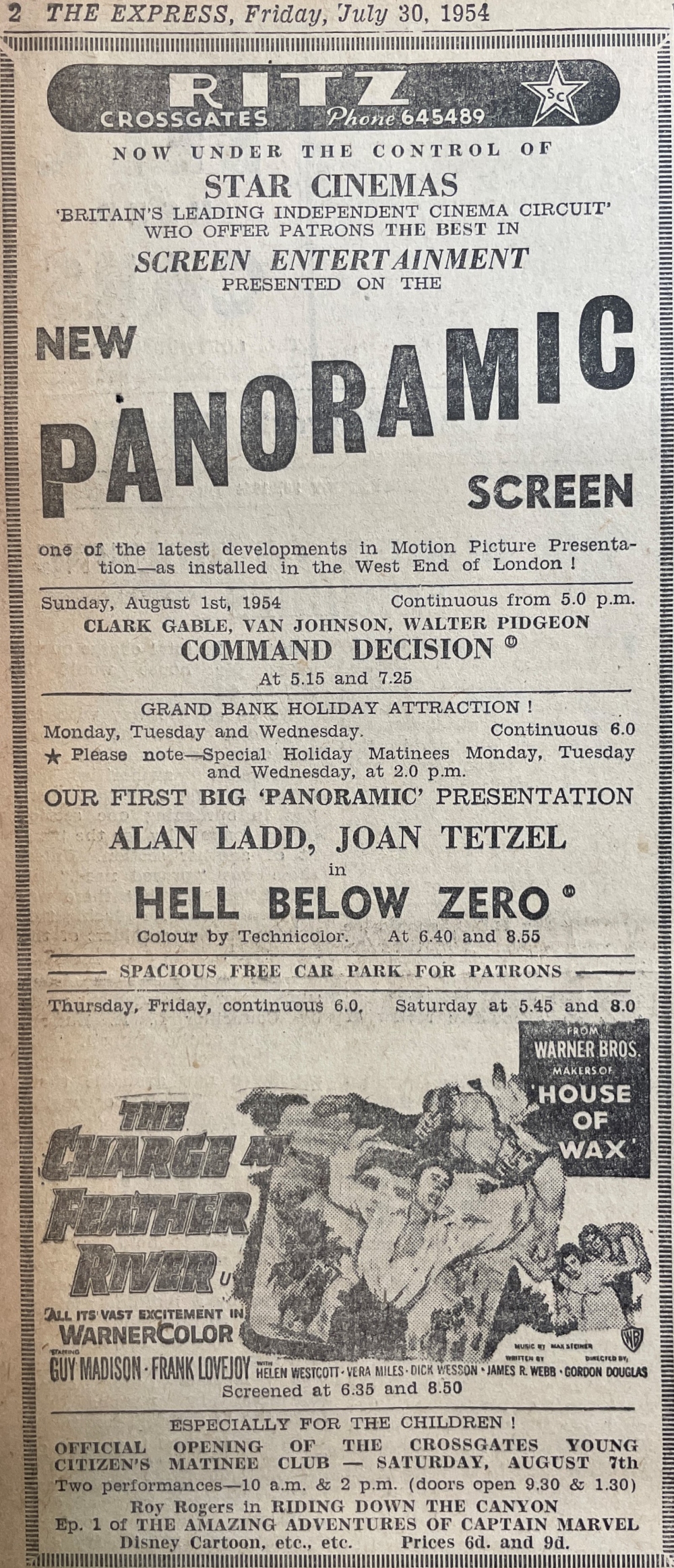 Skyrack Newspaper - 30th July 1954 - Star CInemas Take Over The nearby Regal super cinema would also have been feeling the television pinch and in November 1954 they upgraded to Cinemascope. This widescreen technology was a developed to stem the declining cinema audiences by providing a more immersive experience for patrons, especially when compared to the then very small black and white televisions available. The Ritz installed the same system in September 1957, however due to the narrowness of the building this resulted in a very thin picture which Michael Teal,a patron of the time, remembers jokingly calling it "microscope" instead of "cinemascope!" 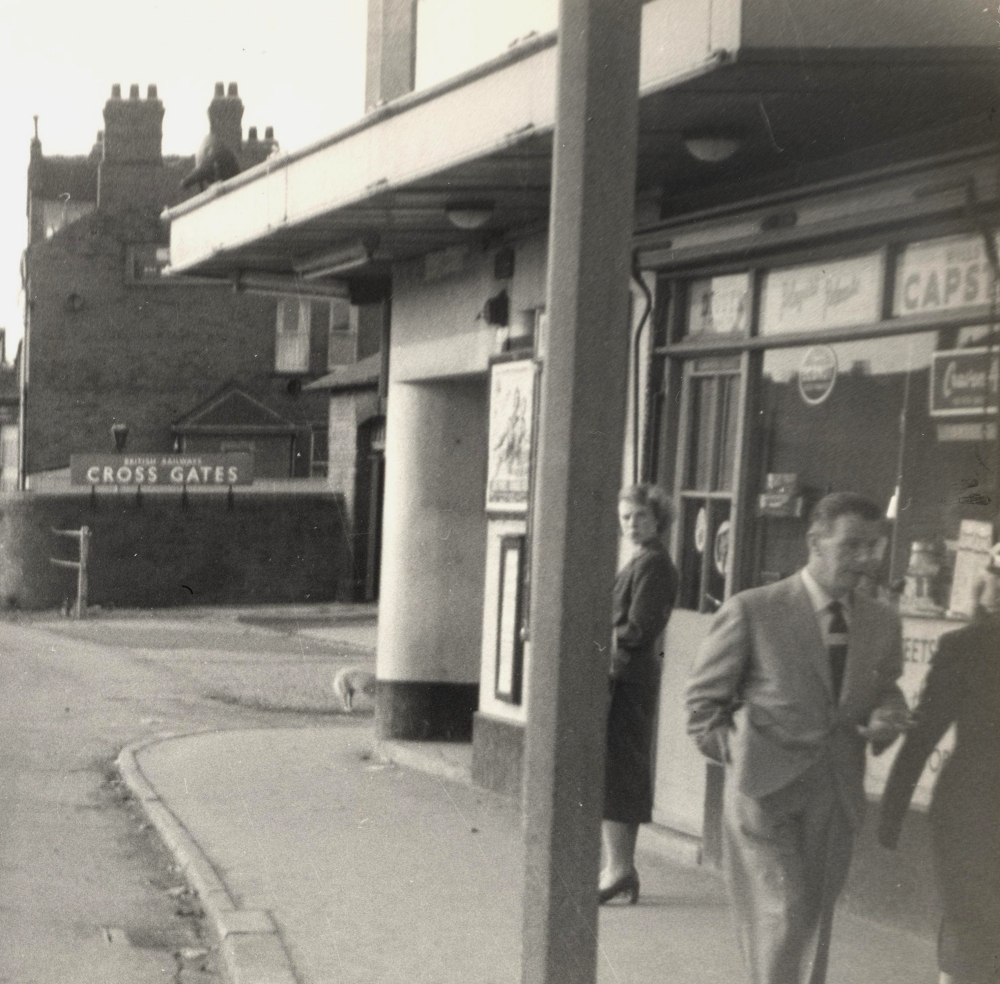 Ritz - entrance and lock up shop - 1950s To further try and increase revenues part of the entrance vestibule was converted in February 1956 to provide a confectionary sales counter and any number of initiatives to increase customers were tried. 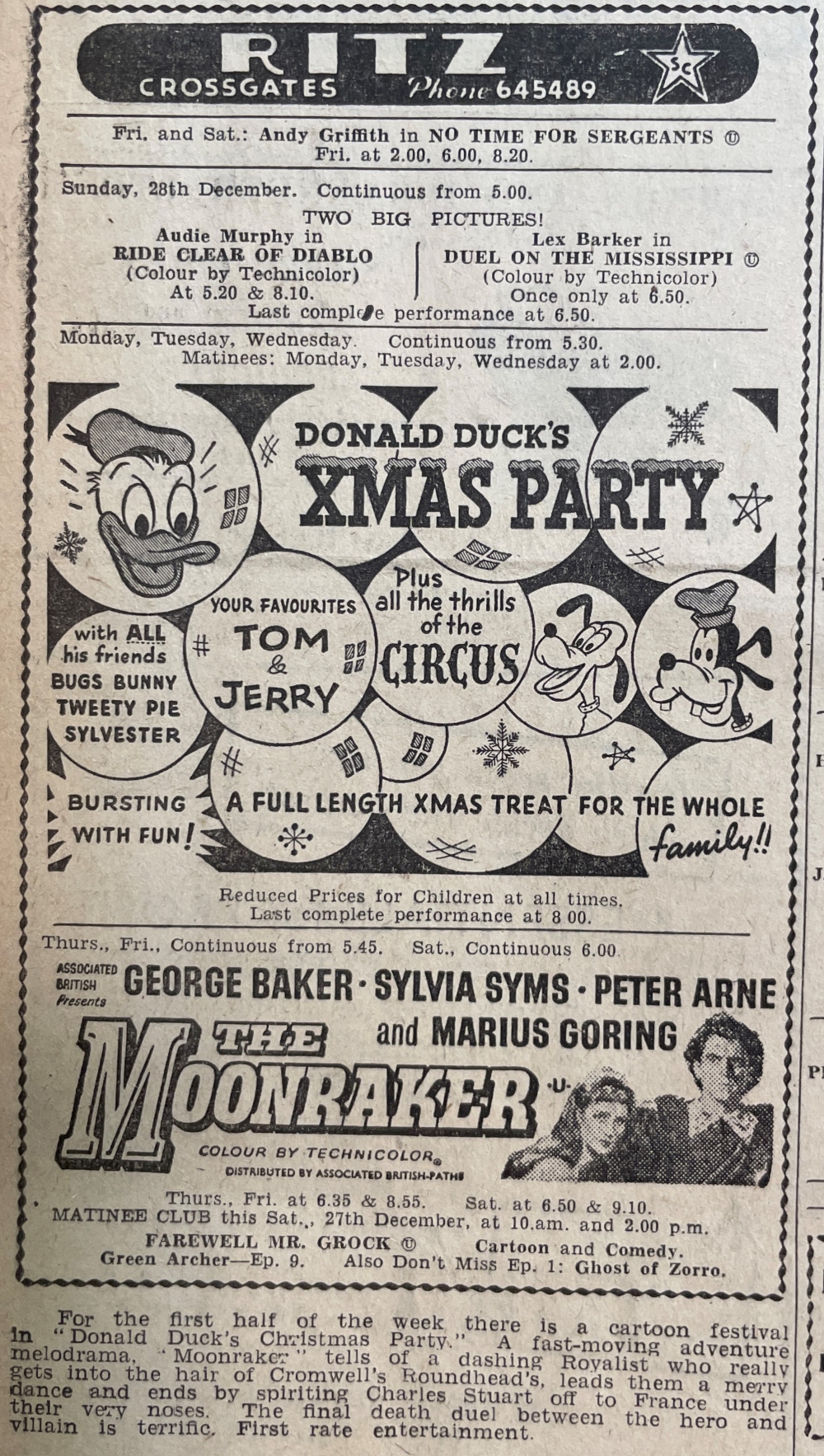 Skyrack Newspaper - December 1958 On Sunday evening 20th April 1958 a local, none televised, heat of the National Skiffle Contest took place in the cinema in conjunction with the ground-breaking teenagers BBC TV show "Six-Five Special". 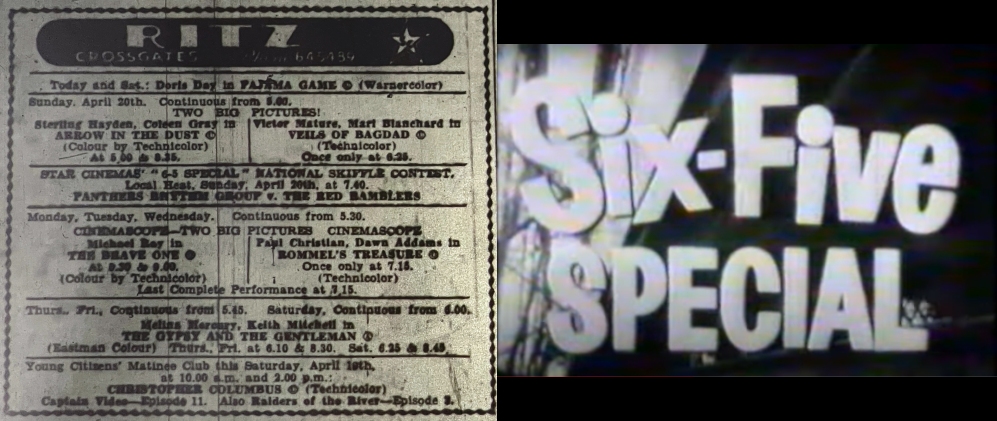 April 1958 - Six-Five Special Skiffle Contest at the Ritz John P. Sayer returned from the USA and took back the managers position and in 1961 organised a "Dress You Doll" competition for the children's matinee club in conjunction with the release of the Disney film "Pollyanna".  Winners in the Pollyanna Contest - March 1961 Still audience numbers dropped, some liberalization of attitudes and film censorship in the early to mid 1960s took place and this may have slightly boosted customer numbers. Recollections from customers of the time however suggest that the cinema was been run on shoestring, locally it had a nickname of the "bug hutch" at this time, no doubt relating to limited cleaning and old and tired seats and fittings. A shock wave ran through Cross Gates in January 1964 when the Regal super cinema closed, the then manageress of the Ritz, Mrs W. Levitt, saying in February 1964 "that so far as she knew there was no question of the Ritz closing down. Since the Regal closed we have done better business". The Ritz struggled on for another 16 months and closed on Sunday 16th May 1965 with a one day only "X" rated double bill of Jeffrey Hunter, Vic Damone in "HELL TO ETERNITY" & Robert Loggia, Ellen Parker in "COP HATER".  Yorkshire Evening Post - Final Ritz Advert - Saturday 15th May 1965 The land and building was sold to a property developer Craticastle Property Company Limited and the buildings demolished in 1966. 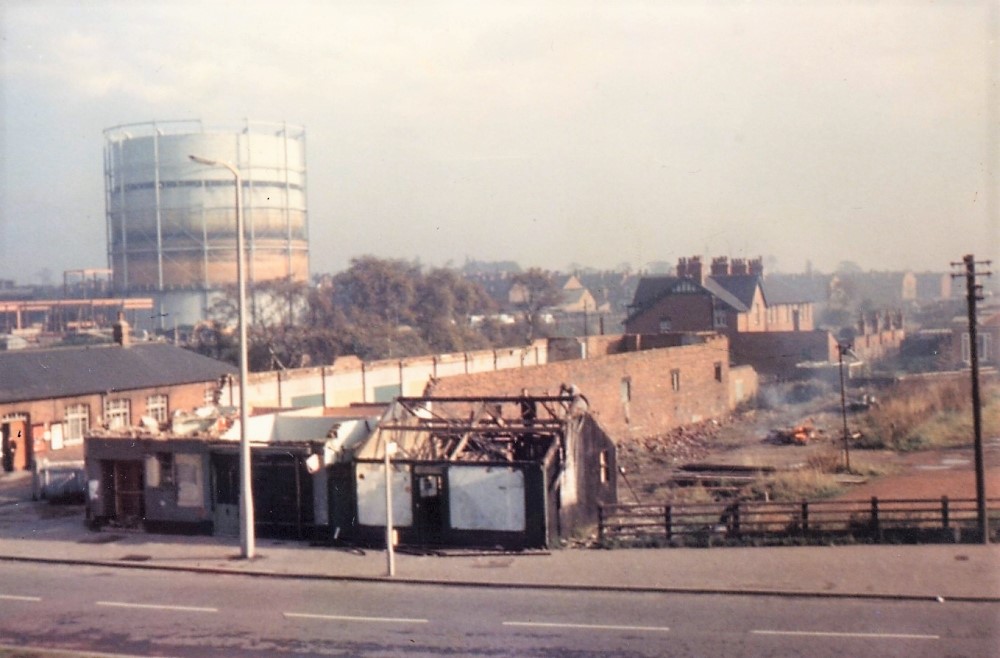 1966 - The Ritz is demolished Planning permission was granted on the 4th October 1966 for 9 shops, 9 flats and a superette, which was not taken forward, a further development proposal in 1971 for a motel also fell through as did a 1973 proposal for Argos and Green Shield Stamp stores. The site remained empty for 20 years until a retail unit was constructed which opened in December 1986. Today there is nothing to indicate the enterainment hub this area once was. Dave Teal April 2022 Back to the top The Cross Gates Picture House Back to the Main Historical Society page Back to the Barwicker Contents page |